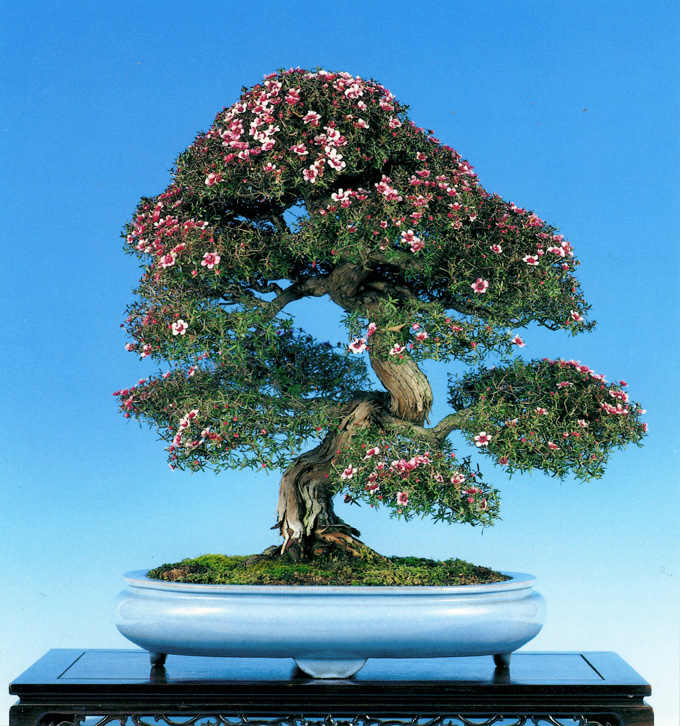 Continuing with Bonsai Today, this gorgeous, sinewy New Zealand tea tree (Leptospermum scoparium) appeared on the cover of issue 96 (still available and 75% off). Not much more needs to be said about this one (it speaks for itself), except maybe to comment on the variety. Though you may occasionally see a New Zealand tea bonsai, in general they are not that common, at least here in the Northern Hemisphere. But, even if you have seen them before, I’ll take a wild guess and venture that you have never seen one quite like this.
Continuing with Bonsai Today, this gorgeous, sinewy New Zealand tea tree (Leptospermum scoparium) appeared on the cover of issue 96 (still available and 75% off). Not much more needs to be said about this one (it speaks for itself), except maybe to comment on the variety. Though you may occasionally see a New Zealand tea bonsai, in general they are not that common, at least here in the Northern Hemisphere. But, even if you have seen them before, I’ll take a wild guess and venture that you have never seen one quite like this.
Thematic incoherence. This post is a bit of a grab-bag with a marked thematic incoherence. Usually, I’ll have a theme in mind or one will emerge as things unfold, but no such luck this time. Now it’s time to move on to the next task, so I guess we’ll just have to take this one as is.
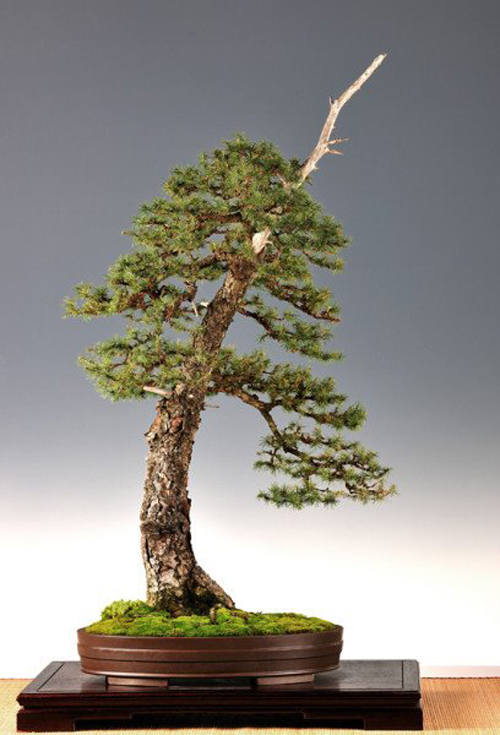 Embarrassed apologies. Do you think that this tree would be more natural looking (and less unusual) without the jin at the top? Either way, I think its clean simple lines combined with the feeling of age imparted by the bark and the taper of the trunk, make for a very lovely tree. The bad news is that I seem to have forgotten where I found it. This is particularly embarrassing as I often make a bit of a deal about the importance of attribution. So my apologies to the bonsai artist that it belongs to. I hope someone recognizes it and sets the record straight. Got it! Thanks to Rasto Moravik (see comments below) we now know that the artist is Piotr Czerniachowski and the tree is a European larch (Larix decidua).
Embarrassed apologies. Do you think that this tree would be more natural looking (and less unusual) without the jin at the top? Either way, I think its clean simple lines combined with the feeling of age imparted by the bark and the taper of the trunk, make for a very lovely tree. The bad news is that I seem to have forgotten where I found it. This is particularly embarrassing as I often make a bit of a deal about the importance of attribution. So my apologies to the bonsai artist that it belongs to. I hope someone recognizes it and sets the record straight. Got it! Thanks to Rasto Moravik (see comments below) we now know that the artist is Piotr Czerniachowski and the tree is a European larch (Larix decidua).
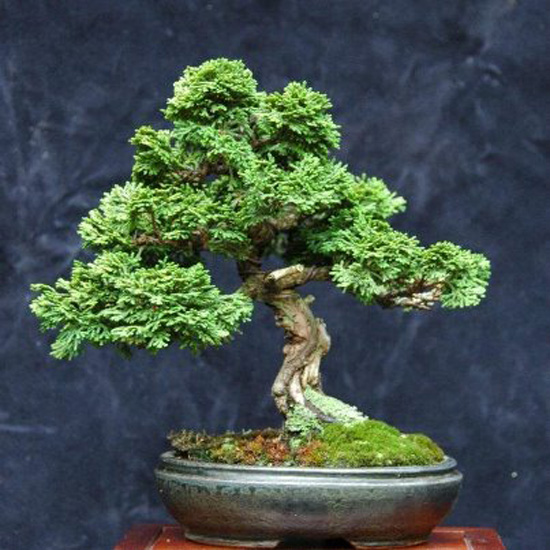 Suddenly it’s Hinoki time. We posted another (much larger) Hinoki cypress (Chamaecyparis obtusa) recently. This one is a Shohin from John Romano’s facebook. Aside from being a little over-potted (for show at least), it has the right stuff, especially its time-tested look and the fluid line of the trunk. Shohin (small bonsai) usually can’t compete with larger bonsai when it come to development, but this one does a pretty good job.
Suddenly it’s Hinoki time. We posted another (much larger) Hinoki cypress (Chamaecyparis obtusa) recently. This one is a Shohin from John Romano’s facebook. Aside from being a little over-potted (for show at least), it has the right stuff, especially its time-tested look and the fluid line of the trunk. Shohin (small bonsai) usually can’t compete with larger bonsai when it come to development, but this one does a pretty good job.
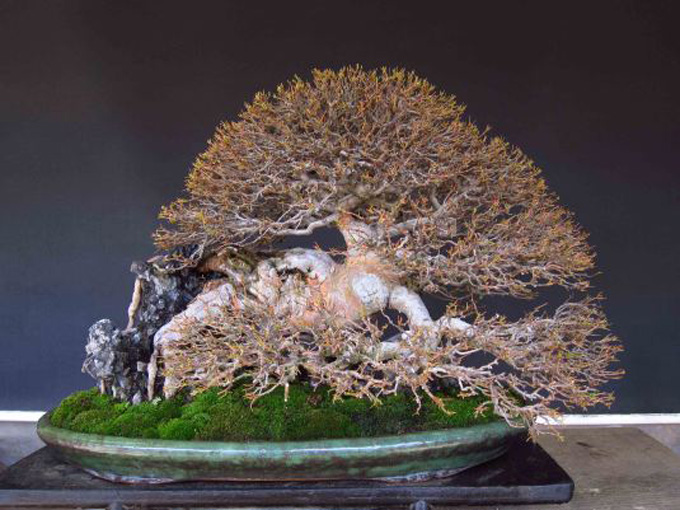 You can do this. In our last post I said this about ramification: “…detailed development is still somewhat rare in Western deciduous bonsai, but quite common in Japan.” Just in case you need another example, this Trident maple from Peter Tea Bonsai blog will do nicely. In Peter’s own words: “Here’s an example of a Trident Maple that has been grown and developed at Aichien. This tree is about 50 years old. The main branches took several years to develop and the densely ramified branches took over 10 years to develop.”
You can do this. In our last post I said this about ramification: “…detailed development is still somewhat rare in Western deciduous bonsai, but quite common in Japan.” Just in case you need another example, this Trident maple from Peter Tea Bonsai blog will do nicely. In Peter’s own words: “Here’s an example of a Trident Maple that has been grown and developed at Aichien. This tree is about 50 years old. The main branches took several years to develop and the densely ramified branches took over 10 years to develop.”
He thinks not. Speaking of Peter Tea, his latest post is titled The End? I Think Not! No spoiler here, you have to see for yourself.
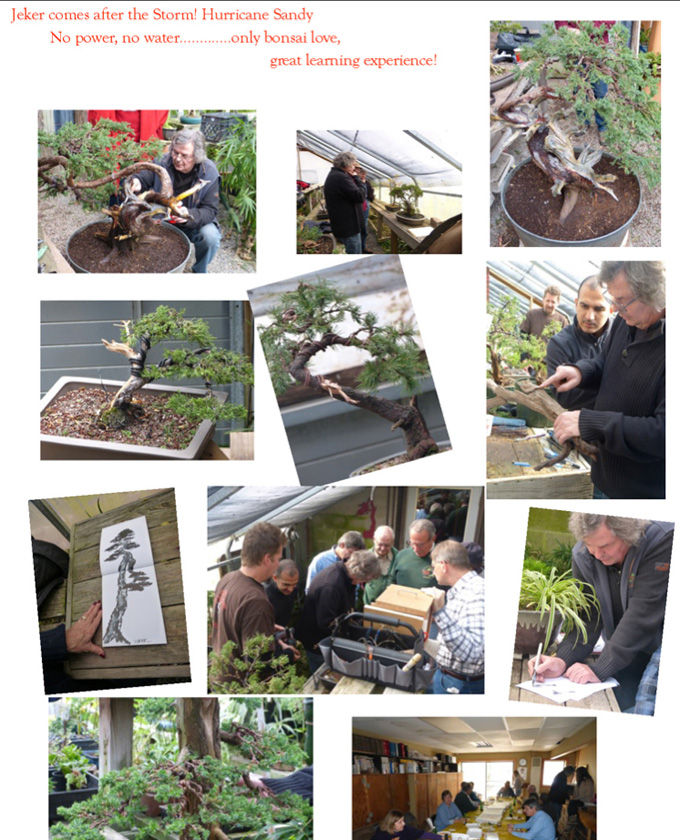 Francois Jeker visited Rosade Bonsai Studio right after Hurricane Sandy dropped by. Though it has been a while since we featured Francois, I’m a big fan of his bonsai (especially his carving) and his excellent one-of-a-kind book.
Francois Jeker visited Rosade Bonsai Studio right after Hurricane Sandy dropped by. Though it has been a while since we featured Francois, I’m a big fan of his bonsai (especially his carving) and his excellent one-of-a-kind book.
I attended the Jeker workshop and had him autograph my book which I purchased from Stone Lantern at the National Bonsai Expo. Francois is a true artist and it definitely comes out in his work. He is very kind and gentle hearted and full of knowledge concerning deadwood on trees. If you don’t already have his book you should get it. Thanks to Chase and Solita Rosade for having Francois out to their studio. I seriously learned a lot that weekend,made some new friends,and had an excellent time.
Thats me in the brown shirt and pictured is my book folded open and autographed with an ink painting by Francois.
I’m also a big fan of Jekers work! Think the Jin on the pine is too long and distracting. Love that little hinoki! And as to deciduous ramification in Noeth America, I agree, but it won’t be much longer before we see trees of that caliber here…in fact, it won’t be much longer before we see THAT tree here! It’s owned by American Matt Ouwinga of Kaede Bonsai En and I’m sure it’ll make it across the pacific(and into some top quality American shows) after it does the show rounds in Japan.
The manuka at the top of the post is amazing, especially as they absolutely hate having their roots disturbed so repotting and root pruning must be almost non existent in this tree.
OMG I have never seen…what a wonder!!
When should we expect to have a translation into English of Jeker’s second volume?
I think the jin is too long and distracting. Looks like a larch ?
Some of us have to overpot our shohin so they will survive the summer heat while we work (to keep roots from drying out.) That one looks just slightly overpotted, but a very nice tree!
Thanks for the plug Steven, and thanks to the Rosades for bring Francois over. This wasn’t the first time they’ve hosted him and hopefully won’t be the last.
HI Ryan,
Aha, something to look forward to. And agreed, we will see that kind of ramification developed here, though we do seem to lag more with deciduous trees that with coniferous ones.
Hi Ann,
Yeah, I’ve often heard the same about tea tree roots, until, as an experiment I root pruned several with any problems. What I attributed the success to was radically cutting back the foliage at the same time the roots were pruned. All the tree recovered nicely and it wasn’t long until the foliage was once again growing vigorously.
HI Miguel,
I’ve heard rumors that it’s about to happen, but nothing definite yet.
Hi Lee,
Yeah, the jin could be reduced for sure. I’m not sure about the variety. The foliage is a bit unclear in the photo, but the bark doesn’t look to me like larch. More like Fir (Picea abies?) but then I’m usually wrong when it come to guessing varieties.
Hi all,
The author of nice natural looking tree with a long jin is polish bonsai artist Piotr Czerniachowski.
It is a Larix Decidua, a common larch.
best regards,
Rasto
Thanks Rasto,
I just updated the post thanks to you filling us in.
-w